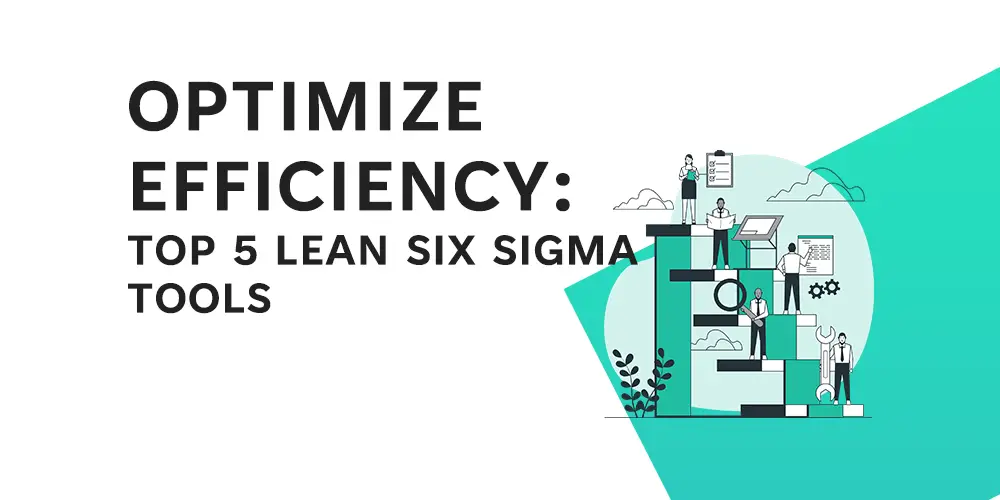Organizations are constantly looking for ways to gain an advantage and spur success in the highly competitive business environment of today. Efficiency stands out among the critical elements that can have a significant impact on performance. For an organization to remain competitive, it is essential to be able to optimize processes, reduce waste, and boost productivity. This is the precise situation where Lean Six Sigma tools are useful.
Operational excellence can be attained through the use of Lean Six Sigma, a potent methodology that combines the waste-reduction principles of Lean with the focus on quality improvement of Six Sigma. Lean Six Sigma enables businesses to deliver exceptional value to customers, cut costs, and promote continuous improvement by removing inefficiencies and streamlining processes.
This blog post will explore the top five Lean Six Sigma tools that have the power to completely transform an organization’s productivity. These tried-and-true tools have proven to be effective across a wide range of industries, and they have the potential to completely change the way you go about process improvement. Join us as we set out on this transformative journey through the world of Lean Six Sigma tools if you’re ready to unleash the true potential of your business and maximize efficiency.
Table of Contents
Lean Six Sigma Tool 1: Value Stream Mapping
What is Value Stream Mapping (VSM) and its purpose
Value Stream Mapping is a visual tool used to analyze and map out the entire flow of materials, information, and activities involved in a specific process or value stream. The main goal of VSM is to find and remove waste, bottlenecks, and non-value-added activities in order to maximize the process’ overall efficiency. VSM enables organizations to visualize the flow of value and make wise decisions for improvement by giving a thorough overview of the current state and desired future state.

Benefits of using VSM to Identify Process Inefficiencies
When it comes to locating process inefficiencies, the use of VSM has many advantages. First off, it enables businesses to recognize and cut out non-value-added activities like needless handoffs, waiting times, and excess production. Organizations can improve efficiency by streamlining processes and cutting lead times by concentrating on value-added steps. Additionally, VSM assists in locating areas of high variation and bottlenecks, allowing for targeted improvements to improve throughput and overall process performance.
Short Guide on how to Conduct a VSM Exercise
Organizations can use the following instructions to carry out a Value Stream Mapping exercise:
- Select the value stream: Determine which specific process or value stream you want to examine and enhance.
- Define the current state: Create a flowchart of the entire process, including all steps, the flow of materials, the flow of information, and the cycle times. To assess the performance in the present, identify the key metrics, such as lead time and process cycle efficiency.
- Identify waste: Analyze the current state map and identify areas of waste, such as overproduction, excess inventory, transportation, waiting time, and defects. Use symbols and annotations to make these wasteful actions very clear.
- Design the future state: Imagine a better future where the identified waste is reduced or eliminated. Streamline the process, shorten cycle times, and maximize the efficient use of resources. To create the desired future state, apply lean principles like pull systems, standardized work, and visual management.
- Create a plan for implementation: Make a thorough implementation plan for the upcoming state improvements. Set realistic deadlines, assign responsibilities, and order tasks according to importance.
Examples of VSM use cases
Examples from everyday life show how Value Stream Mapping can actually improve productivity. For instance, using VSM, a manufacturing company discovered that their production process involved excessive transportation and waiting time. They significantly cut lead times and improved on-time delivery by redesigning the layout, implementing pull systems, and speeding up changeover times, which raised customer satisfaction. Similarly to this, a healthcare organization examined their patient flow using VSM to spot bottlenecks and pointless handoffs. They decreased patient wait times, increased staff productivity, and improved the overall quality of care by putting process improvements based on the VSM findings into place.
By leveraging Value Stream Mapping as a powerful Lean Six Sigma tool, organizations can gain valuable insights into their processes, identify areas of improvement, and make data-driven decisions to optimize efficiency and drive operational excellence.
Lean Six Sigma Tool 2: Root Cause Analysis (RCA)
What is Root Cause Analysis and its purpose
Root Cause Analysis (RCA) is a methodical process that seeks to determine the root causes of issues or incidents rather than focusing only on their symptoms. It is a crucial tool in Lean Six Sigma because it enables organizations to implement efficient and long-lasting solutions by assisting them in identifying the true cause of process problems. Organizations can stop problems from recurring and promote continuous improvement by delving deeply into the root causes.
The Importance of Identifying and Addressing Root Causes of Problems
Sustainable process improvement depends on locating and addressing the sources of issues. Even though treating the problem’s symptoms or immediate problems won’t prevent it from returning, it might give temporary relief. Organizations can eliminate or reduce the factors contributing to the problem and prevent its recurrence by identifying and addressing the root causes. This strategy increases process reliability, quality, and customer satisfaction while also increasing efficiency.
Root Cause Analysis Techniques
Root Cause Analysis uses a variety of techniques to identify the root causes of issues. The following are examples of RCA methods:
Fishbone Diagrams (Ishikawa Diagrams/Cause and Effect Diagram): This technique visually represents the potential causes of a problem by categorizing them into various branches, such as people, processes, materials, machines, and the environment. It aids in systematizing the identification and analysis of potential root causes.

5 Whys: The 5 Whys technique entails repeatedly asking “why” to identify the underlying cause of the observed issue. Organizations can delve deeper and identify the root causes of the issue by repeatedly asking this question.

Pareto analysis: Pareto analysis aids in pinpointing the crucial few factors that underlie the majority of problems. It is based on the Pareto Principle, which holds that the majority (80%) of problems result from a relatively small number of causes (20%). Organizations can concentrate their efforts on addressing the most significant root causes by giving priority to these few important causes.

Examples of RCA Solving Problems
Case studies from real-world situations show how Root Cause Analysis helps to maximize effectiveness. For instance, a manufacturing company frequently experienced equipment failures that caused production delays. They found that the main causes were poor equipment maintenance and a lack of operator training by conducting RCA using methods like Fishbone Diagrams and the 5 Whys. Proactive maintenance and training programs that addressed these problems significantly decreased machine downtime and increased overall production efficiency.
Lean Six Sigma Tool 3: DMAIC Methodology
What is the DMAIC Methodology?
Lean Six Sigma projects frequently employ the structured problem-solving methodology known as DMAIC. Define, Measure, Analyze, Improve, and Control are the five main phases it walks organizations through to provide a systematic framework for process improvement. To maximize effectiveness and encourage continuous improvement, each phase has a distinct goal and set of tasks.

Each Phase of DMAIC and its Purpose in Optimizing Efficiency
Define: The project objectives and scope are established during the Define phase. The main goal is to establish project boundaries, identify customer requirements, and define the problem or opportunity. This stage ensures a targeted approach to process improvement and assists in coordinating project goals with organizational objectives.
Measure: The goal of the Measure phase is to collect data and metrics that can be used to evaluate how well the process is performing right now. It entails creating data collection strategies, carrying out assessments, and establishing performance benchmarks. Organizations can gain insights into the performance of their existing processes and pinpoint areas for improvement by measuring key process parameters.
Analyze: Organizations use the data they have gathered to identify patterns, trends, and possible root causes of process problems. Tools and methods for statistical analysis are used to identify the underlying causes of inefficiencies or defects. Organizations benefit from this phase’s understanding of the connection between process inputs and outputs, which enables them to effectively focus improvement efforts.
Improve: The goal of the Improve phase is to develop and put into action solutions that address the discovered root causes. It entails generating ideas, weighing potential solutions, and picking the best ones. Organizations optimize the procedure and make the necessary modifications to increase efficiency through piloting and testing. To spur significant improvements, this phase places a strong emphasis on innovation and creativity.
Control: During the Control phase, it is made sure that the advancements made during the earlier phases are maintained over time. It entails creating control strategies, putting in place observational systems, and establishing operational standards. Organizations can continuously monitor the process and take corrective action to avoid regression by defining key performance indicators (KPIs) and putting control measures in place.
Examples of DMAIC Used for Process Improvement
Examples from the real world show how DMAIC has improved processes. A logistics company, for instance, used DMAIC to address the issue of a delayed order fulfillment. They significantly decreased order fulfilment time, increased customer satisfaction, and increased overall operational efficiency by defining the issue, measuring order processing time, analyzing root causes like bottlenecks and manual errors, implementing process improvements, and establishing control measures.
Similar to this, a software development company used DMAIC to deal with a persistent problem with software defects. They identified the issue, assessed defect rates, investigated the underlying causes, adopted coding standards and automated testing procedures, and established control mechanisms through the DMAIC phases. They consequently noticed a marked decline in software flaws, increased quality, and simplified development procedures.
Tips to Successfully use DMAIC for Projects in an Organization
Successfully implementing DMAIC projects requires careful planning and execution. Here are some ideas to think about:
Strong project leadership: Select a committed project manager who has the knowledge and experience needed to successfully lead the DMAIC project.
Cross-functional cooperation: Include participants from various departments or functions to guarantee a thorough comprehension of the procedure and acquire a variety of viewpoints.
Data-driven decision-making: Place a strong emphasis on the necessity of gathering precise and pertinent data in order to inform decisions at each stage of the DMAIC process.
Training and support: To improve project team members’ abilities and guarantee successful implementation, provide training and support on DMAIC methodology, statistical tools, and Lean Six Sigma principles.
Continuous monitoring and review: Establish mechanisms to monitor progress, review results, and make necessary adjustments throughout the DMAIC project. This makes sure that gains are maintained and that new opportunities for improvement are found.
Organizations can maximize the benefits of DMAIC projects, improve efficiency, and make significant process improvements by implementing these suggestions.
Lean Six Sigma Tool 4: Statistical Process Control (SPC)
What is Statistical Process Control?
An effective Lean Six Sigma tool for monitoring and controlling processes to ensure they operate within desired parameters and maintain efficiency is statistical process control (SPC). In SPC, data is gathered and analyzed to understand process performance, spot variations, and take preventative action to keep processes in check. SPC assists organizations in identifying areas for improvement and upholding consistent quality by offering insights into process stability and performance.

Key Concepts of SPC
SPC monitors and analyzes process performance using a number of fundamental concepts. One such idea is the control chart, which highlights trends, patterns, and variations in process data as it is graphically represented over time. Organizations can distinguish between common cause and special cause variations using control charts, such as the X-bar and R charts or the individuals (I-MR) chart, which helps with decision-making for process improvements.
Another crucial component of SPC is process capability analysis, which evaluates a process’s ability to consistently meet customer requirements. To quantify the process’ ability to produce within predetermined tolerances, process capability indices like Cp, Cpk, Pp, and Ppk are calculated. Organizations can determine whether a process is capable of meeting customer expectations and pinpoint areas that need improvement using process capability analysis.
Benefits of SPC to Monitor Control and Processes
SPC monitoring and control of processes has a number of advantages. First of all, it gives businesses the ability to spot variations instantly, enabling prompt corrective action. SPC assists in avoiding overcorrection and pointless adjustments by differentiating between common cause and special cause variations, resulting in stable and effective processes. SPC also offers transparency into process performance, enabling data-driven decision-making and resource allocation for focused improvements. SPC helps to improve product quality, lower defects, and boost customer satisfaction by minimizing variations and preserving process stability.
Practical Examples of SPC Being Used
Examples from real-world situations show how SPC improves productivity and lowers variation. For instance, a manufacturing company used SPC to keep an eye on important product dimensions as they were being produced. They improved dimensional accuracy and decreased scrap rates by implementing corrective actions after identifying variations in the machining process using control charts.
SPC was used in the healthcare sector to keep track of emergency room wait times for patients. The hospital used control charts to identify patterns of variation and put new processes into place, such as optimizing resource allocation and triage processes. Waiting times were cut down, patient flow was enhanced, and overall effectiveness rose.
These instances show how SPC enables businesses to recognize variations, take preventative action, and enhance process performance over time. Organizations can increase productivity, lessen variation, and guarantee consistent quality throughout their processes by utilizing SPC as a Lean Six Sigma tool.
Lean Six Sigma Tool 5: 5S Methodology
What is 5S?
The 5S methodology is a Lean Six Sigma tool that places an emphasis on maintaining a clean and organized workplace to increase productivity and efficiency. The term 5S is derived from five Japanese words: Seiri (Sort), Seiton (Set in Order), Seiso (Shine), Seiketsu (Standardize), and Shitsuke (Sustain). It is based on Japanese Lean principles. Each step of the 5S methodology is essential for producing a well-organized, productive, and aesthetically pleasing workspace.

Overview of the 5S Steps
Sort (Seiri): This process entails clearing the workspace of anything that isn’t necessary. It involves assessing and classifying tools, equipment, materials, and other items as necessary or not. Only necessary items are left in the workspace after unnecessary items are either discarded or moved.
Set in Order (Seiton): The main goal of Set in Order is to efficiently and logically arrange the remaining items. It entails designating particular spaces for tools, pieces of machinery, and supplies in order to facilitate access and speedy retrieval. To make it clear where each item belongs, visual cues like labels, shadow boards, and floor markings are frequently used.
Shine (Seiso): The Shine step emphasizes hygiene and routine upkeep. It entails developing a cleaning schedule to make sure that workspaces and equipment are kept tidy and maintained. Regular cleaning helps identify and address potential problems before they worsen, in addition to fostering a safer and more pleasant work environment.
Standardize (Seiketsu): Throughout the organization, consistent practices and procedures must be established. Making sure the 5S principles are utilized consistently throughout various work areas is the goal of this step. Long-term maintenance of efficiency, cleanliness, and organization is facilitated by standardizing processes and visual controls.
Sustain (Shitsuke): Sustain is about creating a culture of continuous improvement and maintaining the gains achieved through 5S. It entails instilling accountability in workers and conducting routine reviews and updates of the 5S practices. Maintaining the 5S principles makes sure that productivity and workplace organization are ingrained in organizational culture.
How 5S Improves Efficiency by Eliminating Waste and Promoting a Clean Workspace
By removing waste and fostering an orderly, clean workspace, the 5S methodology increases efficiency. Workers can locate essential tools and materials more quickly and save time by eliminating unnecessary items (Sort). Everything has a place when things are set in order (Set in Order), which prevents errors and saves time spent looking for things.
Equipment breakdowns are prevented by routine cleaning and maintenance (Shine), which also promotes a secure and effective workplace. Practice standardization (Standardize) promotes consistency, lowers variability, and facilitates more efficient workflows. The 5S philosophy (Sustain) encourages continuous improvement by keeping the workplace efficient and organized over time.
Case Studies of Successful 5S Implementation
Numerous case studies show how 5S has been successfully implemented across numerous industries. For instance, a manufacturing company’s production line benefited from the implementation of 5S by having shorter setup times, better material flow, and higher productivity.
Hospitals have used 5S in the healthcare industry to increase patient safety, decrease errors, and boost productivity. The use of 5S has improved response times, decreased clutter, and streamlined procedures in operating rooms and patient rooms.
These instances demonstrate the adaptability of 5S and its capacity to enhance effectiveness and get rid of waste in various contexts. Organizations can transform their workspaces, increase productivity, improve safety, and foster a culture of continuous improvement by adopting the 5S methodology.
Conclusion
In conclusion, the top five Lean Six Sigma tools described in this blog post give businesses effective ways to boost productivity and promote continuous development.
Value Stream Mapping, Root Cause Analysis, DMAIC Methodology, Statistical Process Control (SPC), and the 5S Methodology are some of the tools that organizations can use to improve quality, streamline processes, and deliver exceptional value to customers.
Implementing these tools is not just a theoretical idea; numerous industries have seen success with them in practice. Take the plunge, adopt these Lean Six Sigma tools, and you’ll open the door to a world where your company’s productivity and performance can be dramatically enhanced.








